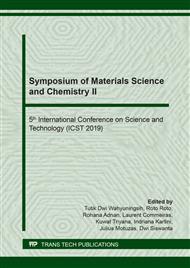p.311
p.318
p.324
p.330
p.336
p.345
p.351
p.360
p.368
Stainless Steel 316 L Metal Coating with Capiz Shell Hydroxyapatite Using Electrophoretic Deposition Method as Bone Implant Candidate
Abstract:
Hydroxyapatite (HAp) made of capiz shell has been successfully coated onto stainless steel 316L substrate using electrophoretic deposition (EPD) method. In this study, three variations were applied, they were the voltages of 25 V and 50 V, the withdrawal speeds of 0.1 mm/s, 0.5 mm/s, and 1 mm/s, and the sintering temperatures of 750, 850, and 950 °C. These variations were applied to determine the differences in morphology and crystal structure of the layers so that the most suitable result was obtained as a candidate for the bone implant. Characterization was done by Scanning Electron Microscope and X-Ray Diffractometer. The EPD process and the application of sintering temperature eliminated the phase of B type apatite carbonate which made the purity of the HAp layer higher. The SEM results show that the layer was more homogeneous and free of cracking at a voltage of 50 V and the withdrawal speed of 0.1 mm/s. The layer density was higher as the voltage and sintering temperature increased. Higher sintering temperature also made the layer more homogeneous, but at 950 °C, stainless steel 316L substrate underwent a phase transformation which caused the decreasing of the purity of the HAp layer. The best results were obtained by applying a50 V voltage, a withdrawal speed of 0.1 mm/s, and a sintering temperature of 850 °C.
Info:
Periodical:
Pages:
336-344
Citation:
Online since:
April 2020
Price:
Сopyright:
© 2020 Trans Tech Publications Ltd. All Rights Reserved
Share:
Citation:


